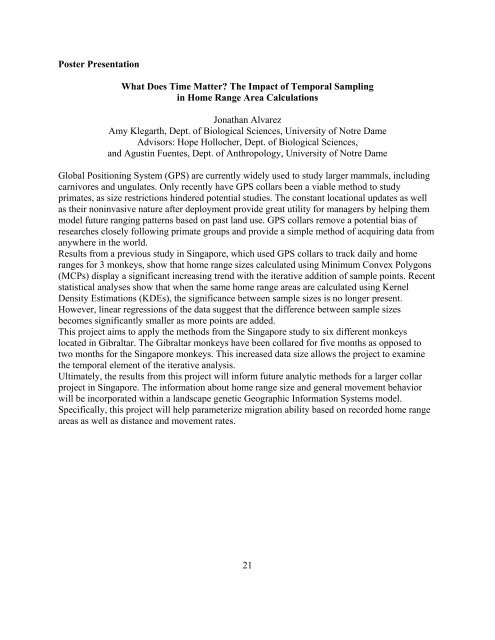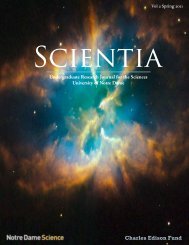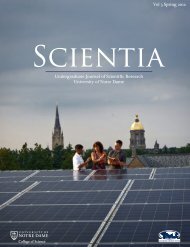Review the symposium abstracts (3.19MB PDF) - College of Science
Review the symposium abstracts (3.19MB PDF) - College of Science
Review the symposium abstracts (3.19MB PDF) - College of Science
- No tags were found...
Create successful ePaper yourself
Turn your PDF publications into a flip-book with our unique Google optimized e-Paper software.
Poster PresentationWhat Does Time Matter? The Impact <strong>of</strong> Temporal Samplingin Home Range Area CalculationsJonathan AlvarezAmy Klegarth, Dept. <strong>of</strong> Biological <strong>Science</strong>s, University <strong>of</strong> Notre DameAdvisors: Hope Hollocher, Dept. <strong>of</strong> Biological <strong>Science</strong>s,and Agustin Fuentes, Dept. <strong>of</strong> Anthropology, University <strong>of</strong> Notre DameGlobal Positioning System (GPS) are currently widely used to study larger mammals, includingcarnivores and ungulates. Only recently have GPS collars been a viable method to studyprimates, as size restrictions hindered potential studies. The constant locational updates as wellas <strong>the</strong>ir noninvasive nature after deployment provide great utility for managers by helping <strong>the</strong>mmodel future ranging patterns based on past land use. GPS collars remove a potential bias <strong>of</strong>researches closely following primate groups and provide a simple method <strong>of</strong> acquiring data fromanywhere in <strong>the</strong> world.Results from a previous study in Singapore, which used GPS collars to track daily and homeranges for 3 monkeys, show that home range sizes calculated using Minimum Convex Polygons(MCPs) display a significant increasing trend with <strong>the</strong> iterative addition <strong>of</strong> sample points. Recentstatistical analyses show that when <strong>the</strong> same home range areas are calculated using KernelDensity Estimations (KDEs), <strong>the</strong> significance between sample sizes is no longer present.However, linear regressions <strong>of</strong> <strong>the</strong> data suggest that <strong>the</strong> difference between sample sizesbecomes significantly smaller as more points are added.This project aims to apply <strong>the</strong> methods from <strong>the</strong> Singapore study to six different monkeyslocated in Gibraltar. The Gibraltar monkeys have been collared for five months as opposed totwo months for <strong>the</strong> Singapore monkeys. This increased data size allows <strong>the</strong> project to examine<strong>the</strong> temporal element <strong>of</strong> <strong>the</strong> iterative analysis.Ultimately, <strong>the</strong> results from this project will inform future analytic methods for a larger collarproject in Singapore. The information about home range size and general movement behaviorwill be incorporated within a landscape genetic Geographic Information Systems model.Specifically, this project will help parameterize migration ability based on recorded home rangeareas as well as distance and movement rates.21






